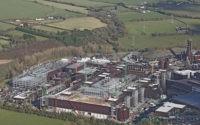Consider all the people, materials and steps that take a building from concept to completion. Following design, an arguably dysfunctional bidding process begins, during which general contractors try to compress costs as much as possible without leaving too much on the table. To do so, they either sacrifice (a) margins or (b) quality to win the work. But what if those sacrifices didn’t have to be made? That’s the true potential when we marry the capabilities of advanced technology with modular manufacturing in a highly integrated approach. By applying efficiencies of scale and volume in a factory setting, neither quality nor price need to suffer on a construction project.
In the traditional building industry model, once the project is secured, it’s up to the various stakeholders — architects, planners, acquisitions experts, engineers, project managers, construction superintendents, and a multitude of subcontractors — to try to reconcile reality with the promised cost. Volume production can reduce these inefficiencies, and more importantly, change the need for each stakeholder’s decision making to be driven by maximizing for a single project.
Another frustrating aspect of the construction industry is the silos that persist between the various stakeholders. From designers to personnel onsite, each is solving for their own priorities and specialties. Compromises must be made and sometimes, they’re fraught.
Tech is Taking Us Far, But Not Far Enough
Technology and mobile connectivity have gone a long way toward fixing these problems. As iPads have gained widespread use on job sites over the past decade-plus, the flow of communication both upstream and downstream has never been easier or more prolific. Similarly, the number of startups and applications that target specific elements of the construction process has exploded since 2012 from two to more than 2,200.
Virtual reality, 3D digital blueprints and Building Information Modeling have also helped project teams better visualize and prepare for what they may encounter as they build. These innovations allow for near real-time adjustments that can be transparent to all. Yet, even with hyper-connectivity during the planning process, breakdowns continue to occur.
For example, raw material prices can suddenly be driven up by swings in tariff policies or supply shocks. Long run and short-term labor shortages also increase the uncertainty of resource plans. Investing in one area means taking away from another, or overextending the budget and taking a loss. But these unexpected events can be offset, in a model where volume production reduces risk.
A New Delivery Model
I recently joined Skender. We are using technology to make volume production possible. We are bridging design, manufacturing and construction, and we’re bringing it all under one roof, literally, in a new advanced manufacturing facility in Chicago. Here, we’ll take building components from the virtual state to the physical state. These modular units — which could be multifamily apartments, healthcare suites or other formats — are going to be shipped to a project site, where all that needs to happen is assembly.
Perhaps the biggest change is happening from the outset to that broken bidding process. We will not have to focus on the profitability of a single project because our model will allow us to apply efficiencies across many projects. We don’t have to sacrifice quality for price, because we’ll be shifting the recovery of costs across a larger portfolio of work, not maximizing allocations to a single project.
If my team and the technology we apply do their job, then they’ll be the underlying structure connecting every piece of a project and every person working on it. The inputs, experiences and outcomes of one project will inform each other. This does not mean cookie-cutter production. This model allows for myriad customization, and as changes are made, we will have a straight line connection to their cost impacts.
The new world order for construction is hyper-connectivity in planning and doing. As we apply this data from one project to 10, 100, and 1,000 more, we can truly benefit from economies of scale, add automation at points where it makes sense and produce aesthetically pleasing, high-quality buildings that can now finally be optimized for affordability.
Stacy Scopano recently joined Skender — a vertically integrated design, construction and manufacturing firm based in Chicago — as chief technology officer. He previously was vice president of innovation at Skanska USA and a business strategist at Autodesk and Trimble.





Post a comment to this article
Report Abusive Comment